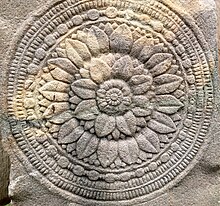
Back رمزية بوذية Arabic Buddhistický symbolismus Czech Budistlikud sümbolid Estonian Buddhista szimbolizmus Hungarian 불교의 상징 Korean Buddhistisk symbolikk NB Simbolismo budista Portuguese Буддийский символизм Russian Buddist ramzi Uzbek Biểu tượng Phật giáo Vietnamese


Buddhist symbolism is the use of symbols (Sanskrit: pratīka) to represent certain aspects of the Buddha's Dharma (teaching). Early Buddhist symbols which remain important today include the Dharma wheel, the Indian lotus, the three jewels and the Bodhi tree.[1]
Buddhism symbolism is intended to represent the key values of the Buddhist faith. The popularity of certain symbols has grown and changed over time as a result of progression in the followers ideologies. Research has shown that the aesthetic perception of the Buddhist gesture symbol positively influenced perceived happiness and life satisfaction.[2]
Anthropomorphic symbolism depicting the Buddha (as well as other figures) became very popular around the first century CE with the arts of Mathura and the Greco-Buddhist art of Gandhara. New symbols continued to develop into the medieval period, with Vajrayana Buddhism adopting further symbols such as the stylized double vajra. In the modern era, new symbols like the Buddhist flag were also adopted.
Many symbols are depicted in early Buddhist art. Many of these are ancient, pre-Buddhist and pan-Indian symbols of auspiciousness (mangala).[3] According to Karlsson, Buddhists adopted these signs because "they were meaningful, important and well-known to the majority of the people in India." They also may have had apotropaic uses, and thus they "must have been a way for Buddhists to protect themselves, but also a way of popularizing and strengthening the Buddhist movement."[4]
At its founding in 1952, the World Fellowship of Buddhists adopted two symbols to represent Buddhism.[5] These were a traditional eight-spoked Dharma wheel and the five-colored flag.
- ^ Coomaraswamy (1998), pp. 1–5.
- ^ Qin, Zhenzhen; Song, Yao (2020-04-08). "The Sacred Power of Beauty: Examining the Perceptual Effect of Buddhist Symbols on Happiness and Life Satisfaction in China". International Journal of Environmental Research and Public Health. 17 (7): 2551. doi:10.3390/ijerph17072551. ISSN 1660-4601. PMC 7177423. PMID 32276426.
- ^ Cite error: The named reference
:8was invoked but never defined (see the help page). - ^ Karlsson, Klemens. Face to face with the absent Buddha: The formation of Buddhist Aniconic art. Diss. Acta Universitatis Upsaliensis, 2000.[1] Archived 2021-10-01 at the Wayback Machine
- ^ Freiberger, Oliver. "The Meeting of Traditions: Inter-Buddhist and Inter-Religious Relations in the West". Archived from the original on 2004-06-26. Retrieved 2004-07-15.
© MMXXIII Rich X Search. We shall prevail. All rights reserved. Rich X Search